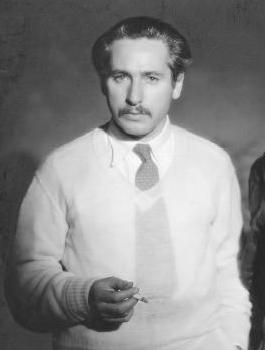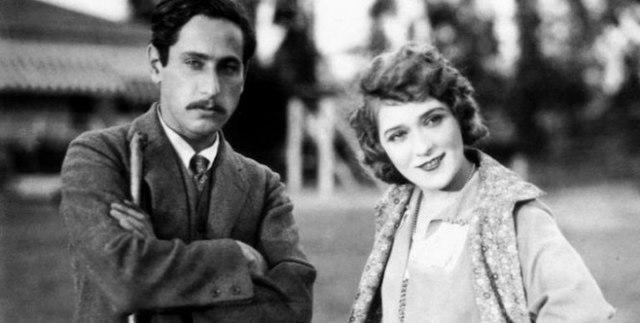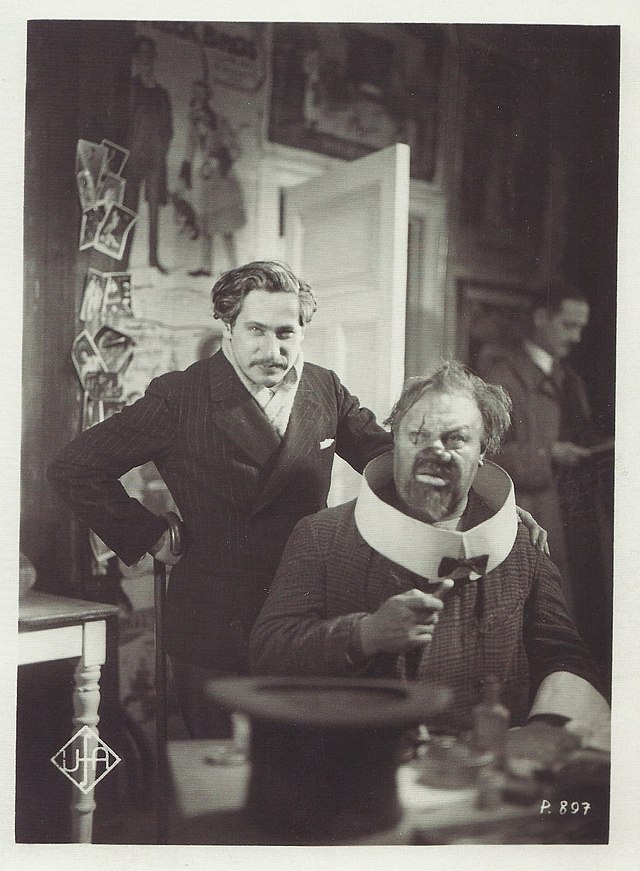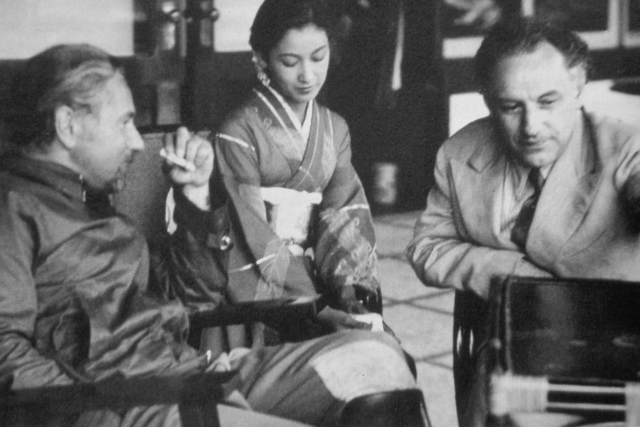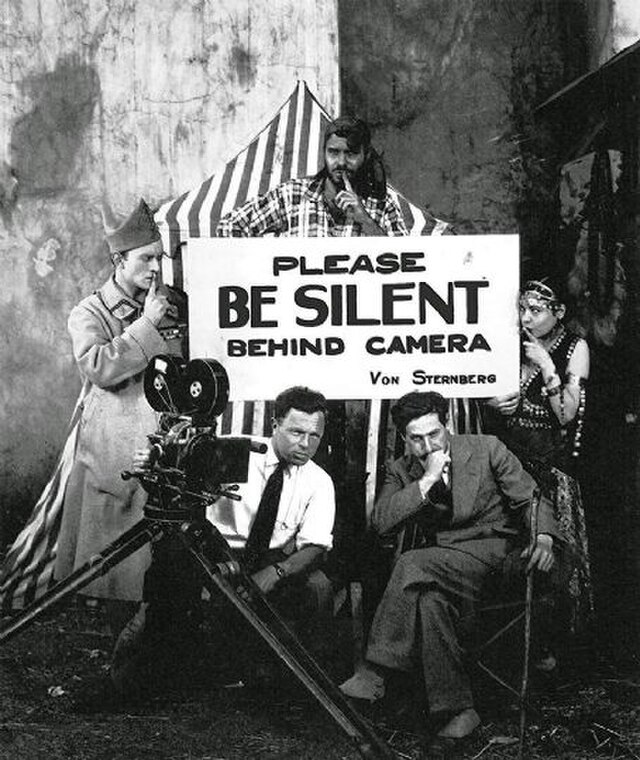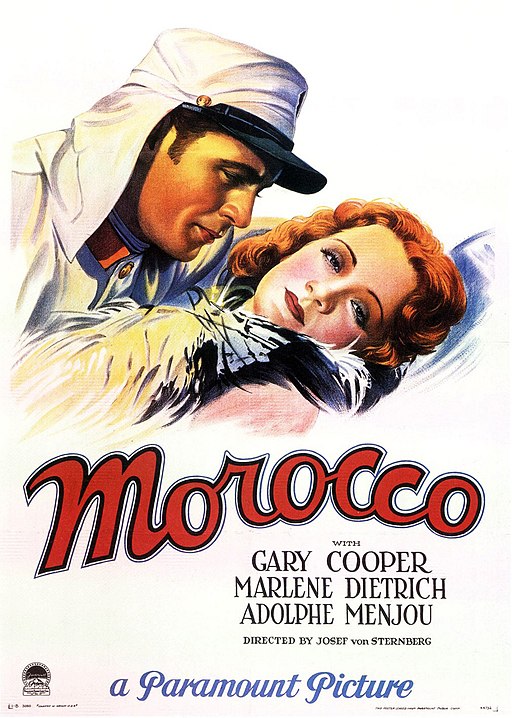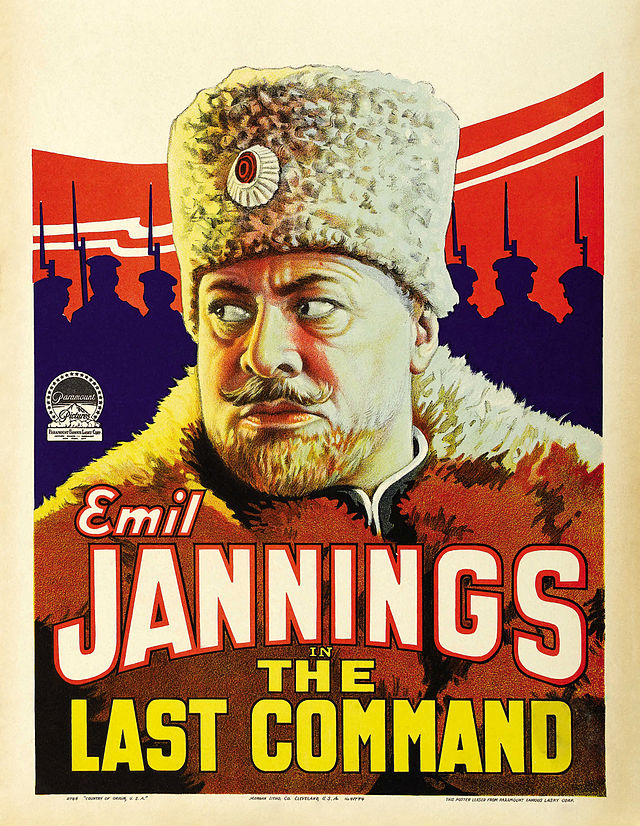Josef von Sternberg
back| Full Name | Jonas Sternberg (later changed to Josef von Sternberg) |
| Born | May 29, 1894 |
| Birthplace | Vienna, Austria-Hungary (now Austria) |
| Died | December 22, 1969 |
| Buried | Westwood Village Memorial Park Cemetery, Los Angeles, California, USA |
| Married to | Riza Royce (m. 1926; div. 1930) - Jean Ainsworth (m. 1945; div. 1947) |
| Children | Nicholas Josef von Sternberg |
| Notable films | The Blue Angel (1930) - Morocco (1930) - Shanghai Express (1932) - Blonde Venus (1932) - The Scarlet Empress (1934) - An American Tragedy (1931) |
Josef von Sternberg
A Cinematic Visionary
Josef von Sternberg was an influential film director known for his unique visual style and collaboration with actress Marlene Dietrich.
Sternberg made his directorial debut with "The Salvation Hunters" in 1925, which garnered critical acclaim and led to a contract with Paramount Pictures. His breakthrough came with "Underworld" (1927), a film that established him as a major Hollywood director and a pioneer of the gangster genre. He received further acclaim with "The Last Command" (1928), which earned Emil Jannings the first Academy Award for Best Actor.
Related
Josef von Sternberg (1894 – 1969)
Biography, Career Overview and all his Movies:
Josef von Sternberg, originally named Jonas Sternberg, was born on May 29, 1894, in Vienna, Austria-Hungary. He was the son of Moses and Serafina Sternberg. In pursuit of better opportunities, the Sternberg family moved to the United States when Josef was a young boy, eventually settling in New York City. The bustling, culturally diverse atmosphere of New York would later influence Sternberg’s eclectic and exotic film style.
Beginnings in Film
Sternberg’s entry into the film industry was humble. He began his career in the early 1910s, working in various capacities, from cleaning film prints to serving as an assistant director. His first significant role came when he worked with French director Emile Chautard, who became a mentor to him. Sternberg’s dedication and eye for detail quickly set him apart from his peers.
In 1925, Sternberg made his directorial debut with "The Salvation Hunters," a low-budget independent film. Despite its modest production values, the film showcased Sternberg’s emerging style and received critical acclaim. It caught the attention of Hollywood, leading to a contract with Paramount Pictures.
Rise to Fame
Sternberg’s early success continued with "Underworld" (1927), a silent gangster film that became a critical and commercial hit. This film is credited with pioneering the gangster genre in Hollywood. Following this, Sternberg directed "The Last Command" (1928), which further solidified his reputation as a masterful director. The film earned its lead actor, Emil Jannings, the first-ever Academy Award for Best Actor.
Collaboration with Marlene Dietrich
The defining chapter of Sternberg’s career began in 1930 when he traveled to Germany and discovered actress Marlene Dietrich. He cast her in "The Blue Angel" (1930), a film that became an international sensation and catapulted Dietrich to stardom. Sternberg and Dietrich returned to Hollywood, where they made six more films together, including "Morocco" (1930), "Dishonored" (1931), "Shanghai Express" (1932), "Blonde Venus" (1932), "The Scarlet Empress" (1934), and "The Devil Is a Woman" (1935).
Their collaboration was marked by Sternberg’s innovative use of lighting and composition, creating visually stunning and emotionally complex films. Dietrich became his muse, and their films together are celebrated for their eroticism, exoticism, and sophistication. Sternberg’s ability to craft atmospheric, almost dream-like sequences set him apart from other directors of his time.
Personal Life
Sternberg’s personal life was as complex as his films. He married Riza Royce in 1926, but their marriage ended in divorce in 1930. In 1945, he married Jean Ainsworth, but this marriage also ended in divorce in 1947. Sternberg had one son, Nicholas Josef von Sternberg, who went on to work in the film industry as a cinematographer.
Despite his professional success, Sternberg’s relationships were often tumultuous. His intense focus on his work and his perfectionist tendencies sometimes strained his personal connections. However, those who worked closely with him admired his genius and dedication to his craft.
Later Career and Legacy
The late 1930s and 1940s were challenging for Sternberg. The advent of new cinematic styles and changing audience tastes meant that his later films did not achieve the same level of acclaim as his earlier work. However, he continued to innovate and experiment. One notable project from this period is "Anatahan" (1953), a Japanese-language film based on the true story of a group of Japanese soldiers stranded on an island after World War II. The film is lauded for its stark realism and psychological depth.
Sternberg’s influence on cinema is profound. His films are studied for their groundbreaking visual techniques, complex characterizations, and bold narratives. He inspired many future directors and cinematographers who admired his ability to create mood and atmosphere through meticulous attention to detail.
Death and Posthumous Recognition
Josef von Sternberg passed away on December 22, 1969, in Hollywood, California. He was buried at Westwood Village Memorial Park Cemetery in Los Angeles. Over the years, his work has been re-evaluated and celebrated in film retrospectives and scholarly studies. His collaborations with Marlene Dietrich remain iconic, and his films continue to captivate new generations of audiences and filmmakers.
Josef von Sternberg’s legacy is one of a visionary artist who pushed the boundaries of cinematic expression. His unique style, characterized by its visual splendor and emotional complexity, ensures that he remains a pivotal figure in the history of film.
Reunion between Josef von Sternberg and Marlene Dietrich:
Visual Directing Style of Josef von Sternberg:
Josef von Sternberg's directing style is renowned for its visual opulence, meticulous attention to detail, and innovative use of lighting and composition.
Visual Opulence and Atmosphere
- Lighting and Shadows:
Sternberg was a master of chiaroscuro, the dramatic use of light and shadow to create depth and mood. He often employed low-key lighting to produce stark contrasts, which added a sense of mystery and tension to his scenes. This technique was particularly evident in his films with Marlene Dietrich, where lighting played a crucial role in highlighting her enigmatic allure.
- Set Design and Art Direction:
His films are characterized by elaborate set designs and intricate art direction. Sternberg's attention to detail extended to every aspect of the mise-en-scène, from the opulent interiors of "The Scarlet Empress" to the exotic locales of "Shanghai Express." These rich environments not only enhanced the visual appeal but also contributed to the storytelling by creating immersive worlds that reflected the characters' psychological states.
Cinematic Techniques and Innovations
- Expressive Use of Camera:
Sternberg’s camera work was fluid and expressive. He often used tracking shots, dolly movements, and intricate framing to create a dynamic visual narrative. His ability to move the camera seamlessly within the scene helped to draw the audience into the story and convey a sense of intimacy or grandeur, depending on the context.
- Symbolism and Visual Metaphors:
He frequently employed visual symbols and metaphors to add layers of meaning to his films. For instance, the recurring motifs of mirrors, veils, and shadows in his work often symbolize themes of identity, deception, and duality. These elements invite viewers to look beyond the surface and explore the deeper implications of the narrative.
Characterization and Performance
- Star Persona and Glamour:
Sternberg had a significant role in shaping the star persona of Marlene Dietrich. He meticulously crafted her screen image, using lighting, costumes, and makeup to enhance her enigmatic and glamorous persona. This collaboration not only defined Dietrich’s career but also set a standard for the creation of star images in Hollywood.
- Complex Characters:
His films often feature complex, morally ambiguous characters. Sternberg delved into the psychological depths of his characters, portraying them with a blend of vulnerability and strength. This complexity is evident in films like "The Blue Angel," where the protagonist’s tragic downfall is depicted with a nuanced, empathetic approach.
Narrative and Thematic Elements
- Exploration of Power Dynamics:
Sternberg’s films frequently explore themes of power, control, and submission. Relationships in his movies are often marked by power struggles, as seen in "The Devil Is a Woman" and "Blonde Venus." These dynamics are portrayed through both the narrative and the visual style, emphasizing the characters’ internal and external conflicts.
- Exoticism and Sensuality:
A recurring theme in Sternberg’s work is the allure of the exotic and the sensual. His films are filled with lush, sensuous imagery that evokes a sense of eroticism and mystery. This is particularly evident in "Morocco" and "Shanghai Express," where the foreign settings and seductive atmospheres play a crucial role in the storytelling.
Legacy and Influence
- Influence on Film Noir:
Sternberg’s stylistic innovations, particularly his use of shadow and light, had a profound impact on the development of film noir. His atmospheric approach to cinematography set the groundwork for the visual style of noir films in the 1940s and 1950s.
- Enduring Visual Style:
His unique blend of visual splendor and psychological depth continues to influence filmmakers. Directors like Orson Welles and Ridley Scott have cited Sternberg as an inspiration, particularly in their use of lighting and set design to create mood and narrative complexity.
Josef von Sternberg’s directing style is a testament to his artistic vision and technical prowess. His films remain celebrated for their visual beauty, emotional intensity, and innovative techniques, securing his place as one of cinema’s great auteurs.
Quotes from Josef von Sternberg:
- On Filmmaking:
"I care nothing about the story, only how it is photographed and presented."
- On His Approach:
"The only reason for being a professional is to be professional."
- On Visual Style:
"A shadow on the wall—a blown-out match—an eye reflected in a glass of wine... these are more important than all the expensive sets, costumes, and shots."
- On Collaboration:
"I always saw Marlene as a living work of art. She was my canvas, my muse."
- On Creativity:
"I believe in a mixture of reality and imagination. The result is something quite different from either one."
- On His Films:
"Every picture I have made, whether in Hollywood or elsewhere, has been an effort to compose a picture as a painter composes a canvas."
- On Art and Commerce:
"One should never confuse the art and the business of filmmaking. The art must always come first."
- On Directing Actors:
"I direct in an atmosphere of quiet so that the actor becomes the voice of my silence."
Awards and Recognition:
Academy Awards (Oscars)
Nominations:
Best Director:
- "Morocco" (1930)
Wins:
While Josef von Sternberg himself did not win an Academy Award, his film "The Last Command" (1928) helped Emil Jannings win the first-ever Academy Award for Best Actor.
Venice Film Festival
Nominations:
Golden Lion:
- "The Shanghai Gesture" (1941)
Kinema Junpo Awards
Wins:
Best Foreign Language Film Director:
- "Anatahan" (1953)
Other Honors and Recognitions
National Film Registry:
Several of Josef von Sternberg’s films have been selected for preservation in the United States National Film Registry by the Library of Congress for being "culturally, historically, or aesthetically significant." These include:
- "The Blue Angel" (1930)
- "The Last Command" (1928)
- "The Docks of New York" (1928)
- "Underworld" (1927)
Retrospectives and Lifetime Achievement:
Over the years, Sternberg’s work has been honored through numerous film retrospectives at prestigious film festivals and institutions around the world. These retrospectives celebrate his contributions to the art of filmmaking and ensure that new generations of audiences and filmmakers continue to appreciate his work.
Collaboration between Josef von Sternberg and Marlene Dietrich:
The collaboration between Josef von Sternberg and Marlene Dietrich is one of the most legendary and influential partnerships in film history. Here are key aspects and insights into their collaboration:
Discovery of Dietrich:
Josef von Sternberg discovered Marlene Dietrich in Berlin in 1929 while casting for his film "The Blue Angel." At the time, Dietrich was a relatively unknown actress, but Sternberg saw great potential in her. He cast her in the lead role of Lola Lola, a cabaret singer, which would become a defining moment in both their careers.
"The Blue Angel" (1930):
This German film was their first collaboration and became an international sensation. Dietrich's performance as the seductive Lola Lola catapulted her to stardom. Sternberg's direction, with its meticulous attention to lighting, set design, and camera work, highlighted Dietrich's magnetic screen presence.
Move to Hollywood:
After the success of "The Blue Angel," Sternberg brought Dietrich to Hollywood, where they signed with Paramount Pictures. Their collaboration continued with a series of successful and visually stunning films that cemented their legacy in cinema.
Notable Films:
- "Morocco" (1930): Dietrich played a cabaret singer who falls in love with a Foreign Legionnaire, played by Gary Cooper. The film featured Dietrich in a tuxedo, challenging gender norms and enhancing her iconic image.
- "Dishonored" (1931): Dietrich starred as a World War I spy, showcasing her versatility and Sternberg's flair for creating atmospheric and emotionally charged scenes.
- "Shanghai Express" (1932): Set on a train journey through war-torn China, the film is renowned for its exotic visuals and complex characters. Dietrich's role as a mysterious woman with a hidden past was captivating.
- "Blonde Venus" (1932): Dietrich played a woman who becomes a nightclub singer to support her family, featuring memorable musical performances and dramatic moments.
- "The Scarlet Empress" (1934): A historical drama about Catherine the Great, noted for its opulent set designs and grandiose style. Dietrich's transformation from a naive princess to a powerful empress was masterfully depicted.
- "The Devil Is a Woman" (1935): Their final collaboration, set in Spain, featured Dietrich as a femme fatale who manipulates and captivates men. The film's intricate visual style and narrative complexity were highlights of their partnership.
Visual Style:
Sternberg's films with Dietrich are characterized by their lush visual style, elaborate set designs, and innovative use of lighting and shadows. He often used backlighting and intricate lighting setups to create a halo effect around Dietrich, enhancing her enigmatic and glamorous persona.
Character Development:
Sternberg crafted complex, multi-dimensional roles for Dietrich, allowing her to showcase her acting range. Her characters were often strong, independent women with a blend of vulnerability and allure, reflecting Sternberg's interest in exploring the depths of human emotion and power dynamics.
Iconic Image:
Sternberg played a crucial role in shaping Dietrich's public image. He meticulously directed her performances, selected her costumes, and controlled her on-screen appearance. This collaboration resulted in Dietrich becoming an international style icon and a symbol of sophisticated glamour.
Decline and Final Film:
Their professional relationship began to strain towards the mid-1930s. "The Devil Is a Woman" was their last film together. After this, both moved on to different projects, but the impact of their collaboration remained significant.
Cinematic Influence:
The films created by Sternberg and Dietrich are considered masterpieces and are studied for their innovative techniques and artistic achievements. Their work together set new standards for visual storytelling and character development in cinema.
Enduring Impact:
The collaboration between Sternberg and Dietrich is celebrated for its artistic brilliance and the creation of some of the most memorable and visually stunning films in the history of cinema. Their partnership not only defined their careers but also left an indelible mark on the film industry.
Movies directed by Josef von Sternberg
- The Salvation Hunters (1925)
- A gritty, realistic drama about three down-and-out individuals who find hope and redemption in each other amidst the harsh realities of life.
- The Exquisite Sinner (1926)
- A lost silent film about a composer who leaves his bride to seek inspiration but is later reunited with her.
- A Woman of the Sea (1926)
- A lost silent film produced by Charlie Chaplin, focusing on the lives of fishermen and their families.
- Underworld (1927)
- A pioneering gangster film about a criminal named Bull Weed and his relationships with his moll and a reformed alcoholic lawyer.
- The Last Command (1928)
- A drama about a former Russian general who ends up working as an extra in Hollywood and is cast in a film that mirrors his own past.
- The Dragnet (1928)
- A silent crime film about a detective who infiltrates a gang of criminals to bring them to justice.
- The Docks of New York (1928)
- A romance between a rough-and-tumble stoker and a down-on-her-luck woman he saves from drowning.
- Thunderbolt (1929)
- A talkie about a gangster named Thunderbolt Jim Lang who is captured and sentenced to death, but not before he tries to reconcile with his girlfriend.
- The Blue Angel (1930)
- A German film about an elderly professor who falls for a cabaret singer and spirals into ruin. This film introduced Marlene Dietrich to international stardom.
- Morocco (1930)
- A romantic drama about a love triangle between a cabaret singer, a wealthy man, and a Foreign Legionnaire in North Africa.
- Dishonored (1931)
- A spy thriller about a woman who becomes a secret agent for Austria during World War I and falls in love with the enemy.
- An American Tragedy (1931)
- An adaptation of Theodore Dreiser's novel, telling the story of a young man who becomes involved in a love triangle that ends in tragedy.
- Shanghai Express (1932)
- An adventure drama set on a train traveling through war-torn China, focusing on the passengers' intersecting lives and secrets.
- Blonde Venus (1932)
- A drama about a woman who becomes a nightclub singer to support her family after her husband falls ill.
- The Scarlet Empress (1934)
- A historical drama about the rise of Catherine the Great from a naive young princess to the powerful Empress of Russia.
- The Devil Is a Woman (1935)
- A romantic drama set in Spain about a femme fatale who ruins the lives of the men who fall for her.
- Crime and Punishment (1935)
- An adaptation of Dostoevsky's novel about a man who commits murder and struggles with his guilt.
- The King Steps Out (1936)
- A light-hearted romantic comedy about a young woman who poses as her sister to avoid an arranged marriage, only to fall in love with the man.
- I, Claudius (1937)
- An unfinished historical epic about the life of the Roman Emperor Claudius, based on the novels by Robert Graves.
- Sergeant Madden (1939)
- A drama about an Irish-American police sergeant and the conflicts within his family, particularly with his son.
- The Shanghai Gesture (1941)
- A melodrama set in Shanghai, revolving around a nightclub owner, a young gambler, and a mysterious woman.
- The Town (1943)
- A short documentary film about the life of residents in a small American town, showcasing their daily routines and community spirit.
- Macao (1952)
- A film noir set in the exotic locale of Macao, involving an adventurer, a nightclub singer, and a local crime boss.
- Jet Pilot (1957)
- A Cold War romance about an American Air Force colonel who falls in love with a Soviet pilot who defects to the West.
- Anatahan (1953)
- A drama based on the true story of Japanese soldiers stranded on an island in the Pacific who refuse to believe that World War II has ended.
- The Seagull (1968)
Synopsis: An adaptation of Anton Chekhov's play, which remained unfinished and was one of Sternberg’s final directorial efforts.

